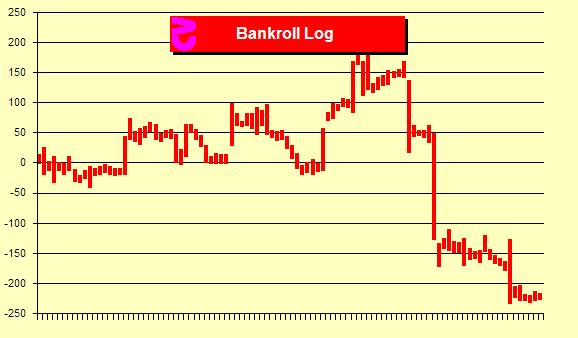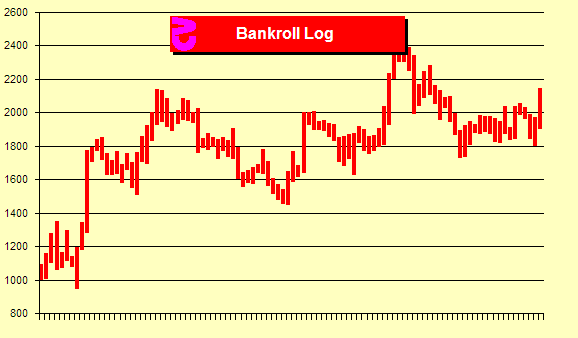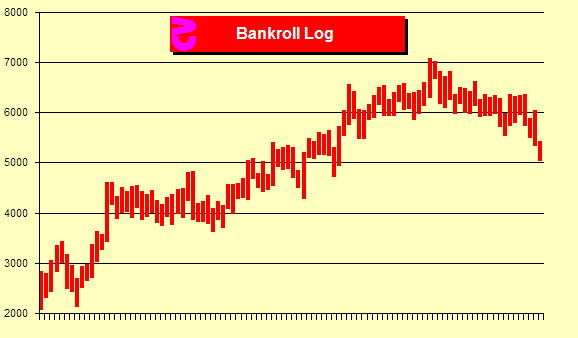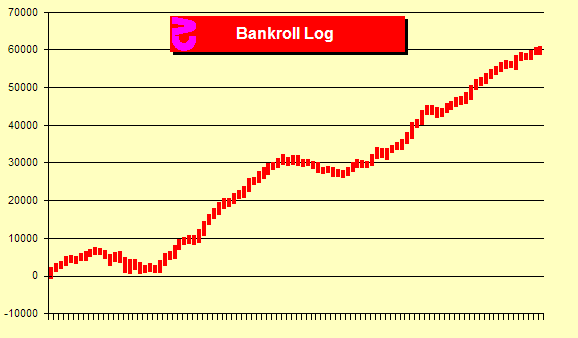|
|
Chapter 7. Blackjack Variance and Volatility Data
| Volatility is our worst enemy. On the other hand, if we merely
won exactly 1% of every hand we played, we would have the most boring
job in existence. This chapter takes a quick look at volatility, and
the next chapter expands on the subject to look at effects.
" May you live in interesting times" — reputed
ancient Chinese curse
| |
 What
are long and short runs? What
are long and short runs?
There are four charts on this page displaying results starting
with the short term (1,000 hands) and moving through successively
longer terms (up to a million hands). We start with a chart displaying
the total won or lost for a card counter playing 1,000 hands. The
1,000 hands are displayed in 100 groups of ten hands each. Each
group of ten hands is a vertical line showing the minimum and maximum
overall result from the start of the chart during those ten hands.
So the last bar in the chart shows that in hands 991 through 1,000,
our results varied between -220 to -226 units. We can see a few
large swings denoted by the long vertical lines. This is not a surprise.
Most of the time we make small bets. But when the count rises, we
can make several max bets and experience a large swing. This chart
shows these occasional large swings and the fact that we can easily
end up behind in 1,000 hands.
|
|

Now we move to 10,000 hands in groups of 100. The y-axis has been
expanded to a larger range. We see some very large swings. The tenth
line shows a range from about 1,300 to 1,800 units in 100 hands.
At some point in those 100 hands we were 1,300 units ahead and at
another point we were 1,800 units ahead for a swing of 500 units.
Although we ended up winning in this particular set of 10,000 hands,
the volatility is obvious and we clearly could have lost. Although
winning is more likely, we do see some punishing downturns and do
not end the chart at our highest point.
|
|

Let's expand this to 100,000 hands in groups of 1,000. We see the
y-axis has expanded again as our results in this section range from
2,000 units ahead to 7,000 units ahead. The line is starting to
look smoother. But we still see long flat periods and dips. And
we can see that at one point we were ahead 7,000 units but ended
up a bit over 5,000 units. At least the overall trend is up.
|
|

Finally, 1,000,000 hands in groups of 10,000. Here we start at zero
units won and end up with 60,000 units won. The line is much smoother,
although there exist clear downturns. If we expanded this to one
billion hands we would then see a nearly straight line.
There is a lot of talk about the long term and short term in Blackjack.
Basically the only difference is that the more you play, the more
likely your actual play will match theoretical advantage. The fewer
hands you play, the more random your results. Which is to say that
short-term results have no meaning. You cannot project advantage
or long-term results from short-term results.
|
Sim details
- Six decks, S17, DAS, LS, 4.8/6 penetration, 4 players, 1-15
spread, Hi-Lo, truncate, full indexes, half-deck resolution
- One million rounds
|
|
|
 What
are long and short runs?
What
are long and short runs?

